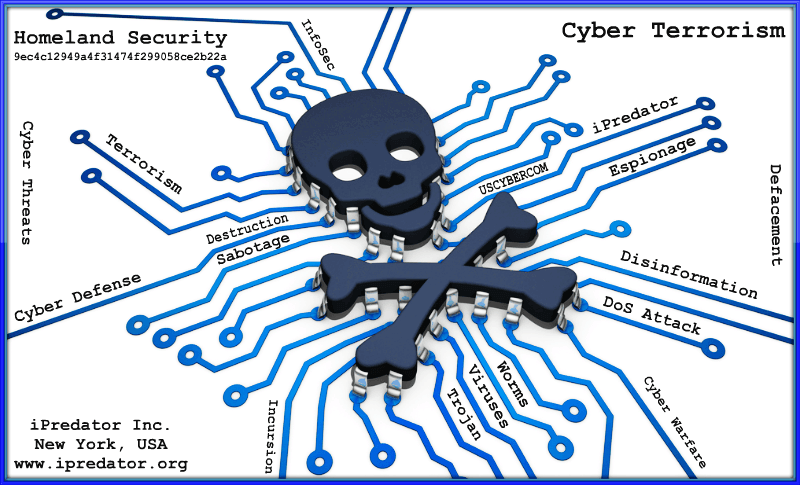Cyber Terrorism

Cyber Terrorist iPredator Typology
Cyber terrorism has multiple definitions and applies to a variety of cyber-attack intricacies that may involve one online assailant or many. As a typology of iPredator, Cyber terrorism is defined as the cognitive, affective, behavioral and motivational factors of terrorist groups or their agents who use Information and Communications Technology (ICT) to impair, harm or destroy non-combatant targets.
Cyber terrorism is different from activism, hacktivism and cybercrime in that the primary purpose of a cyber terrorist attack is to cause physical violence or extreme financial harm. According to the U.S. Commission of Critical Infrastructure Protection, cyber terrorist targets include the banking industry, military installations, power plants, air traffic control centers, and water systems.
More specifically, cyber terrorism attempts to interrupt, destroy or exploit another group or nation’s ICT vulnerabilities to adversely affect their critical infrastructure. The targets cyber terrorists mostly attack are civilian populations and governments. The target is not one individual, but groups, communities, regions and nations. Furthermore, cyber terrorism, as an iPredator typology, requires the terrorist group or their agents to meet three criteria as follows:
- A self-awareness of causing harm to others, directly or indirectly, using ICT.
- The usage of ICT to obtain, exchange and deliver harmful information.
- A general understanding of Cyberstealth used to engage in criminal or deviant activities or to profile, identify, locate, stalk and engage a target.
Although these three factors are broad and could easily include activists, hacktivists and cybercriminals, cyber terrorism focuses on causing physical harm to others by adversely affecting a target group’s ICT networks and critical infrastructure. As humanity becomes more reliant upon ICT, ICT networks and critical infrastructure are synonymous. Like the classic definition of pre-Information Age terrorism, cyber terrorists target civilian populations or those not engaged in active combat. As stated, cyber terrorists use ICT to harm civilian and commercial systems, which directly or indirectly creates an instant or substantial risk to national security.
Cyber Terrorism and Cyber Attack Prevention
As Information and Communications Technology (ICT) becomes more widespread, cyber terrorism prevention, education and protection are areas requiring immediate attention. The Information Age has many benefits to humanity, but it is vital to identify and prevent the malevolent and nefarious elements that exist in cyberspace and Information and Communications Technology. The definition and motivations of iPredator and Cyber Terrorism is as follows:

What is Cyber Terrorism
Cyber Terrorism: Cyber Terrorism is defined as the use of Information and Communications Technology (ICT) by iPredators, organized groups and/or terrorist groups to advance their agenda motivated by religious, political and/or philosophical ideologies. Examples of cyber terrorism include:
1. The use of ICT to organize and execute attacks against networks, and Information and Communications Technology (ICT) infrastructures.
2. The exchanging of information or making threats electronically.
3. The act of hacking into computer systems.
4. Introducing viruses and malware to vulnerable networks.
5. Defacement of websites and blogs.
6. Denial-of-service attacks.
7. Terroristic threats made via electronic communication.
When strategic cyber-attacks are motivated for financial gain, these attacks are defined as cybercrime. Cyber terrorism is a premeditated political, religious or philosophically motivated attack against information, computer systems, computer programs and data, which results in violence against non-combatant targets by sub-national groups or clandestine agents.
18 U.S. Code § 2331 – Definitions
18 U.S. Code § 2332 – Criminal Penalties
(click text links to visit sites)
A cyber terrorist attack is designed to cause physical violence or extreme financial harm to the targeted victims or the community. According to the U.S. Commission of Critical Infrastructure Protection, cyber terrorist targets include the banking industry, military installations, power plants, air traffic control centers and water systems. The F.B.I. define cyber terrorism as “The premeditated, politically motivated attack against information, computer systems, computer programs and data which result in violence against noncombatant targets by sub-national groups or clandestine agents.” Cyber Terrorism is one category of iPredator that will continue to grow with the expansion of Information and Communications Technology.
Homeland Security and Cyber Terrorism Resources
- Department of Defense: http://www.defense.gov/
- US Department of Homeland Security: http://www.dhs.gov/
- US Cyber Command: http://www.defense.gov/home/features/2013/0713_cyberdomain/
- US Northern Command: http://www.northcom.mil/
- Center for Information Warfare Training https://www.public.navy.mil/netc/centers/ciwt/Default.aspx
- Central Intelligence Agency: https://www.cia.gov/index.html
- Federal Bureau of Investigations: http://www.fbi.gov/
- Department of Justice: http://www.justice.gov/
Michael Nuccitelli, Psy.D.
Michael Nuccitelli, Psy.D. is a NYS licensed psychologist, cyberpsychology researcher and online safety educator. In 2009, Dr. Nuccitelli finalized his dark side of cyberspace concept called iPredator. Since 2010, he has advised those seeking information about cyberbullying, cyberstalking, cybercriminal minds, internet addiction and his Dark Psychology concept. By day Dr. Nuccitelli is a practicing psychologist, clinical supervisor and owner of MN Psychological Services, PLLC. After work and on the weekends, he volunteers helping online users who have been cyber-attacked. Dr. Nuccitelli’s is always available to interested parties and the media at no cost. This website and everything created by Dr. Nuccitelli is educational, free and public domain.
